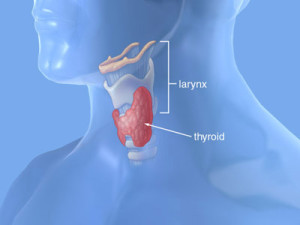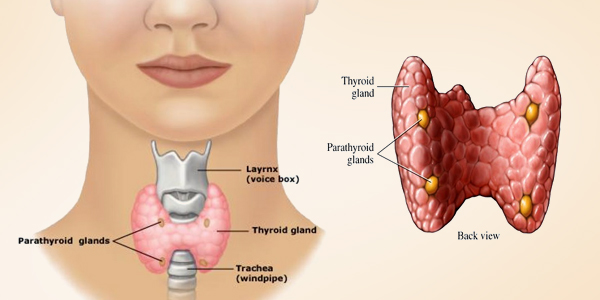Thyroid & Parathyroid Surgery
Our surgeons are renowned head and neck surgeons at C/V ENT Surgical group in Los Angeles and Thousand Oaks, represent a select number of surgeons in the country that routinely perform minimally invasive thyroidectomy as well as minimally invasive parathyroidectomy in select patients after careful workup. The standard approach for these lesions has and continues

Thyroid Gland
to be in many centers around the country a standard 4-5 inch collar incision in the lower neck. However, the physicians here utilize small 1 to 1.5 inch incisions in the lower neck hidden in a usual skin crease to perform these delicate procedures with the aid of either endoscopes or eye-loop magnification. This surgery has only come to fruition over the past few years and only certain surgeons in the country are qualified or have completed advance training to be able to perform these delicate and complicated surgeries. As such the surgeons at C/V now spend a part of their time teaching others in the field these skillfully demanding procedures. Furthermore Dr. Cohen is now Director of the Minimally Invasive Thyroid/Parathyroid Surgery program and West Hills Medical Center, the only center in the San Fernando and Conejo Valleys.
Minimally Invasive Thyroid Surgery
The thyroid is a gland in the front of the neck. It sits just below the voice box. The gland’s main job is to make thyroid hormone. This helps control the body’s metabolism. Thyroid surgery may be done to treat an enlarged thyroid (goiter,) a lump (nodule,) an overactive gland (hyperthyroid,) or a gland that may have cancer cells.
Minimally Invasive Parathyroid Surgery
The parathyroid glands are small jelly-bean size glands that reside on the back surface of the thyroid gland along the recurrent laryngeal nerves with two glands on each side. They are respectively termed left inferior, left superior, right inferior or right superior. The parathyroid glands control the calcium in your blood. Primary hyperparathyroidism causes increased levels of blood calcium (hypercalcemia). This can lead to a number of problems throughout your body. To treat primary hyperparathyroidism, the enlarged gland or glands are often removed with surgery.
Hemithyroidectomy
A hemithyroidectomy is a surgical procedure where only half of the thyroid gland is removed in cases where a suspicious nodule is found on one side or the fine needle aspiration (FNA) cannot definitely determine if a nodule is benign or malignant.
Total Thyroidectomy
During a total thyroidectomy, usually a minimally invasive incision (2 inches) is made in the lower central neck and the entire thyroid gland is dissected and removed while preserving both recurrent laryngeal nerves and all four parathyroid glands.

Thyroid Cancer Surgery
Thyroid cancers are divided into four types, namely papillary, follicular, medullary and anaplastic thyroid carcinoma. Rare thyroid cancers include lymphoma, sarcoma and squamous cell carcinoma.
Thyroid Goiter Surgery
A thyroid goiter is the significant enlargement of the thyroid gland, which leads to difficulty breathing and/or swallowing or voice changes. This type of enlargement is usually not associated with cancer or hormone overproduction.
Parathyroid Exploration
In certain situations when a patient with primary hyperparathyroidism has a non-localizing sestamibi scan or a patient has secondary/tertiary hyperparathyroidism, a parathyroid exploration must be performed.
Central Neck Compartment Dissection
The central neck compartment describes the collection of lymph nodes in the paratracheal, pretracheal, delphian and mediastinal regions. It can be accessed through the same incision that is used to perform a thyroidectomy.
Lateral Neck Compartment Dissection
This is a more extensive procedure than a central neck dissection and involves removal of the majority of lymph nodes in the lateral neck compartment. The lateral neck compartment involves the jugulodigastric, jugular chain and posterior neck lymph nodes of Levels II, III, IV and V.

